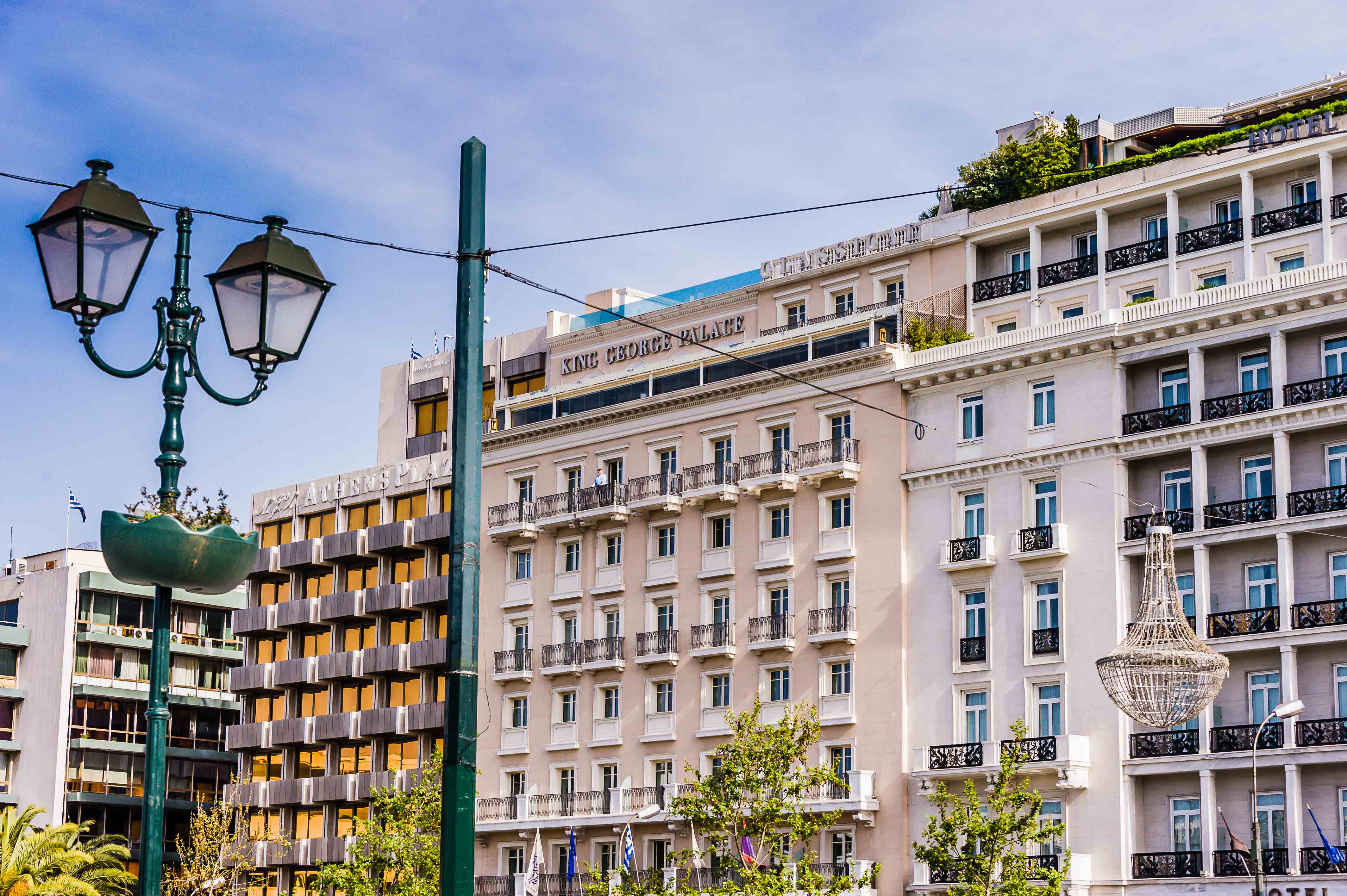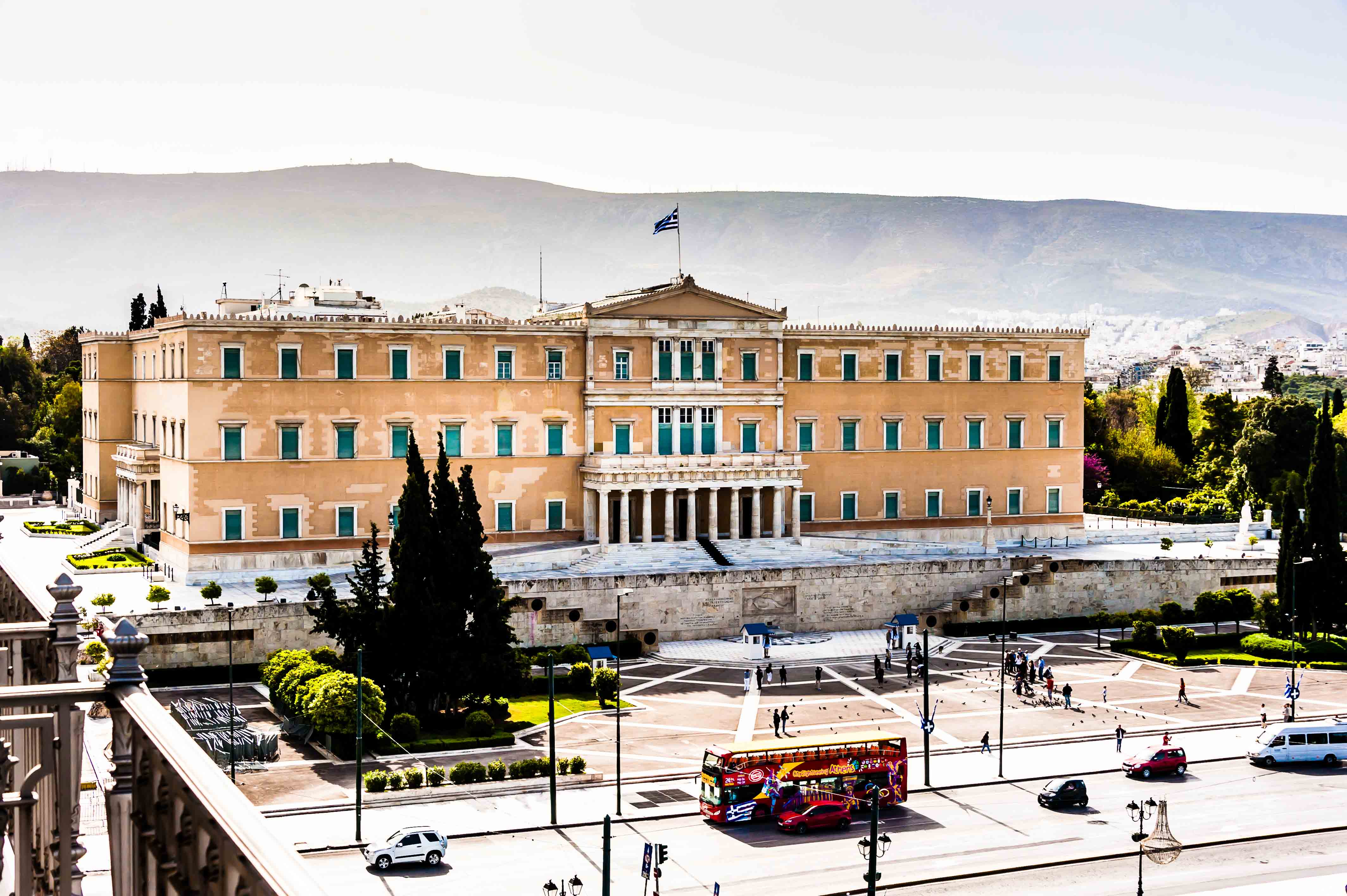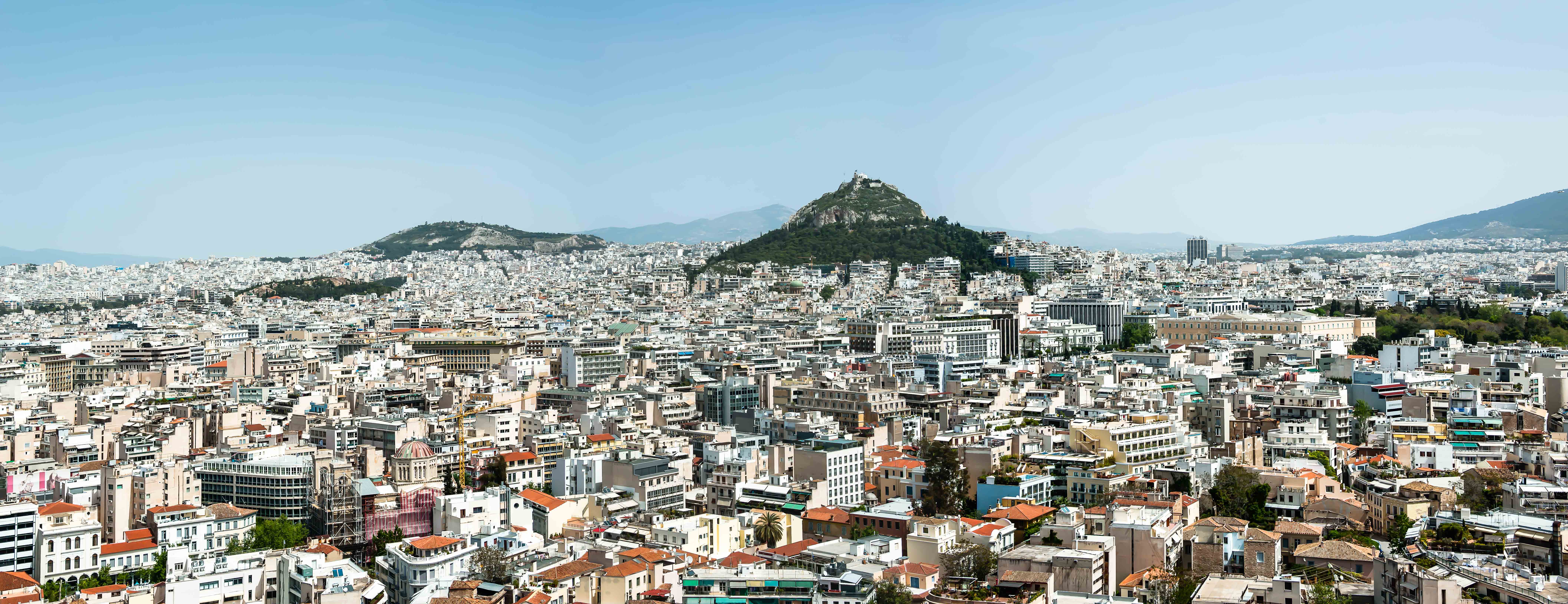Today we grabbed a taxi and headed to the airport armed with all of our bags. About an hour later later we were all checked in on our American Airlines flight to LAX.
Last night we went to a nice dinner at Compass Rose and then put our bags outside the room by 10 pm. The next morning we grabbed a quick breakfast at La Veranda and then took our roll-a-board and carry bags and waited for our color to be called. We said goodbye to as many friends we could find and headed down to collect our bags.
We hailed a taxi, loaded all of our bags and headed downtown to our hotel. It was a pretty warm, somewhat hazy day and the drive on the freeway wasn’t particularly interesting. You could see some of the famous sites in the surrounding hills but the city itself was crowded, a mass of humanity, with nothing to write home about…or write about in a blog for that matter.
Here are the Top Pictures for Athens:
Click here for the complete Picture Gallery for Athens.
The King George hotel was very nice and directly across the street from the square where people had been shot the prior week during demonstrations against government cut-backs. It was also directly across from the Parliament building, complete with marching soldiers and changing of the guard ceremonies every hour. We checked in, left out bags with the bellhop and went out to get some lunch and do some sightseeing.
After exploring the subway system, which was very modern, we grabbed a taxi and headed to the Acropolis. It’s easy enough to read up on all the history of this area. Let’s just say that we did the “fast food” version of a tour of all the famous, crumbling ruins here. There was a lot of construction going on with many cranes, scaffolds and, honestly, many unsafe areas to walk. It was reasonably crowded, hot and, after taking a few pictures, we escaped the crowds and headed back the hotel. I guess you could say we felt that we had “been there, done that”.
Our hotel room was ready and it was very nice, with very high ceilings, nice bed, a TV that worked well and Margaret unpacked a bit and laid down for a nap. Dale went out to take some pictures of the changing of the guard and to explore the area around the hotel. That took less than an hour.
After a bit of a rest we headed to dinner at the hotel restaurant which had a lovely outdoor patio with a nice view of the Acropolis which, when lit up at night was rather impressive, albeit in the distance. The dinner was very nice and we were in bed by 9 pm, ready to take off in the morning for our long trip home.
Today we took it easy while the Voyager traversed our last sea day as we head to Athens. Of course, it is bittersweet that this long trip is almost over and it is always sad to start packing all our bags. But, we are excited to get home and see our puppy and kitty cat and get back to our homes.
Today Margaret and I took a walking tour around Haifa. Very laid back self-guided tour using a map that was provided by local people on the ship. I decided that the Baha’í Hanging Gardens of Haifa, being one of the most visited tourist attractions in the middle east, a UNESCO World Heritage Site and simply amazing was a must-do so we headed up the hill to this amazing sight.
I have to say that before yesterday I had never heard of this religious group. Here’s a little background taken directly from Wikipedia:
The Bahá’í Faith is a monotheistic religion which emphasizes the spiritual unity of all humankind. Three core principles establish a basis for Bahá’í teachings and doctrine: the unity of God, that there is only one God who is the source of all creation; the unity of religion, that all major religions have the same spiritual source and come from the same God; and the unity of humanity, that all humans have been created equal and that diversity of race and culture are seen as worthy of appreciation and acceptance.[3]According to the Bahá’í Faith’s teachings, the human purpose is to learn to know and to love God through such methods as prayer, reflection and being of service to humanity.
The Bahá’í Faith was founded by Bahá’u’lláh in 19th-century Persia. Bahá’u’lláh was exiled for his teachings from Persia to the Ottoman Empireand died while officially still a prisoner. After Bahá’u’lláh’s death, under the leadership of his son, `Abdu’l-Bahá, the religion spread from its Persian and Ottoman roots, and gained a footing in Europe and America, and was consolidated in Iran, where it suffers intense persecution. After the death of `Abdu’l-Bahá, the leadership of the Bahá’í community entered a new phase,evolving from a single individual to an administrative order with both elected bodies and appointed individuals. There are probably more than 5 million Bahá’ís around the world in more than 200 countries and territories.
In the Bahá’í Faith, religious history is seen to have unfolded through a series of divine messengers, each of whom established a religion that was suited to the needs of the time and to the capacity of the people. These messengers have included Abrahamic figures—Moses, Jesus, Muhammad, as well as Dharmic ones—Krishna, Buddha, and others. For Bahá’ís, the most recent messengers are the Báb and Bahá’u’lláh. In Bahá’í belief, each consecutive messenger prophesied of messengers to follow, and Bahá’u’lláh’s life and teachings fulfilled the end-time promises of previous scriptures. Humanity is understood to be in a process of collective evolution, and the need of the present time is for the gradual establishment of peace, justice and unity on a global scale.
On the evening of 22 May 1844, Siyyid `Alí-Muhammad of Shiraz, Iran proclaimed that he was “the Báb” (الباب “the Gate”), referring to his later claim to the station of Mahdi, the Twelfth Imam of Shi`a Islam. His followers were therefore known as Bábís. As the Báb’s teachings spread, which the Islamic clergy saw as a threat, his followers came under increased persecution and torture.[14]The conflicts escalated in several places to military sieges by the Shah’s army. The Báb himself was imprisoned and eventually executed in 1850.
Bahá’ís see the Báb as the forerunner of the Bahá’í Faith, because the Báb’s writings introduced the concept of “He whom God shall make manifest”, a Messianic figure whose coming, according to Bahá’ís, was announced in the scriptures of all of the world’s great religions, and whom Bahá’u’lláh, the founder of the Bahá’í Faith, claimed to be in 1863. The Báb’s tomb, located in Haifa, Israel, is an important place of pilgrimage for Bahá’ís. The remains of the Báb were brought secretly from Iran to the Holy Land and eventually interred in the tomb built for them in a spot specifically designated by Bahá’u’lláh. Although he died in Akka Bahá’ís regard his resting place at Bahjías as the Qiblih to which they turn in prayer each day.
The gardens were designed in 1987 and opened in 2001 and extend almost a kilometer up the side of Mount Carmel and cover 200,00 square meters of land. Nine concentric circles provide the main geometry of the eighteen terraces. Just as the identification of a circle presupposes a centre, so the terraces have been conceived as generated from the Shrine of the Báb. The eighteen terraces plus the one terrace of the Shrine of the Báb make nineteen terraces total. Nineteen is a significant number within both the Bahá’í and Bábí religions.The gardens are linked by a set of stairs flanked by twin streams of running water cascading down the mountainside through the steps and terrace bridges.
After we walked up all the stores to the top, giving us an expansive view of the city and port area we walked around town looking for a good place to eat. However, we never saw anything that we would think would be healthy food and, after getting a coffee, walked back to the ship for a “free” lunch on board. After all, the ship was leaving at 2 pm anyway and we had to be on board by 1:30. Worked out well and we had a relaxing afternoon reading and just hanging out. The Crew Capers extravaganza took place at 6 pm followed by and had a great dinner with our friends at Compass Rose. We ended the evening on the back deck bar. Good times and the last night on our 90 day adventure that we would be together with them. It was starting to hit us that we would be going home in just a couple days.
Here are the Top 15 shots from Haifa:
Click here to view the entire Smugmug Gallery for this day.
We drove past landscape that varied from very rocky to lush green fields to beautiful fields of red wildflowers that were peppered with people picking them, a truly beautiful sight. After about 45 minutes we got a glimpse of the Sea of Galilee with the Golan Heights in the distance. This reinforced the feeling that Israel is a very small country surrounded by enemies as in 1967 they took the Heights from Syria and, to this day, it is governed under Israeli law.
The Sea of Galilee, is the largest freshwater lake in Israel, and it is approximately 64 sq. miles with a maximum depth of approximately 141 feet. At 702 ft. below sea level, it is the lowest freshwater lake on Earth and the second-lowest lake (after the Dead Sea, a saltwater lake). The lake is fed partly by underground springs although its main source is the Jordan River, which flows through it from north to south.
Our first stop was at a touristy place called Yardenit which is said to be the site where John the Baptist baptized Jesus. The Jordan River is apparently filled with silt because it is a slow moving brown river about 30 feet across. Fairly large, but apparently friendly river rats were plying there way along the shore and in the river, within 30 feet of where a group of body-length T-shirt-clad tourists were receiving full submersion baptisms. They were very emotional about it and I captured a few pictures that really told that story. The rats sort of scared me off from trying to take part in the baptism euphoria. That, and the fact that I didn’t want to get all covered in nasty brown water for the rest of our bus ride.
Much of the ministry of Jesus occurred on the shores of Lake Galilee. In those days, there was a continuous ribbon development of settlements and villages around the lake and plenty of trade and ferrying by boat. The gospels of Mark, Matthew, and Luke describe how Jesus recruited four of his apostles from the shores of Lake Galilee: the fishermen Simon and his brother Andrew and the brothers John and James.
Leaving Yardenit we drove along the shore and past the city ancient Roman city of Tiberias which is now peppered with large resort hotels, high rise condos and seaside campers in little pop-up tents. Quite a site. While all the surprised people on the bus gawked at all the campers I managed to get some pretty good shots of the campers and even a nice shot of beautiful yellow and white umbrellas setup near the Hotel Leonardo. Turns out, Israelis really know how to have a good time and relax!
Leaving the shore we then drove past more green and yellow fields and even some banana trees! Seems that, while agriculture is only about 6% of Israel’s GDP they have become fairly water efficient at becoming a major citrus grower and even bananas. One of Jesus’ famous teaching episodes, the Sermon on the Mount, is supposed to have been given on a hill overlooking the lake and it has been celebrated as being such for over 1600 years. Good enough for me. Many of his miracles are also said to have occurred here including his walking on water, calming the storm, the disciples and the boatload of fish, and his feeding five thousand. We arrived at the location where this is said to take place at the Mt of Beatitudes.
Pope Paul VI visited this site in 1964 and it is well advertised around the site. Remains of a cistern and monastery circa 4th-7th century are on the site as is a Roman Catholic Franciscan chapel where Pope John Paul II celebrated Mass on March 2000. It was a lovely setting with many interesting mosaics and stained glass windows.
Next we traveled a short distance to the city of Capernaum. I remembered this name from our bible studies as being a place where Jesus spent quite a bit of time with Peter. There are ruins of what is supposed to be Peter’s house where the rock was located on which he built the church. There is also the ruins of an ancient church called The White Synagogue which has beautiful columns with lots of carvings and on which site was previously the Synagogue of Jesus.
Nazareth is the largest city in the North District of Israel. Nazareth is known as “the Arab capital of Israel” and the population is made up predominantly of Arab citizens, the majority of whom are Muslim. In the New Testament, the city is described as the childhood home of Jesus, and as such is a center of Christian pilgrimage, with many shrines commemorating biblical events.
We went to the place where Jesus is said to have grown up after his parents returned from his birth in Bethlehem and their escape from Herod’s baby killing spree to Egypt. It is said that Joseph was a carpenter in Nazareth and one of the pictures shows the place where Jesus lived and where he would have learned the trade from his father. Like most things here there is a lot of confusion, conjecture and research being done based on excavations that have taken place over many years. But, it’s a good story nonetheless and inspiring to visualize what might have taken place here.
The group took a tour of a beautiful church called The Church of St. Joseph. In the courtyard outside there were about 50 beautiful mosaics representing important parts of the Gospel and each was created and donated by a different country. I have pictures of most of them in the complete Gallery. There were also some great statues around the property. People watching in Nazareth was very interesting and they were more than happy for me to take their picture. We also had some time to have a snack from the local vendors and restaurants including having a nice cold beer.
One thing’s for sure. There has been a lot of change over the last few thousand years in this area as one group after another came in, destroyed and killed, set up their government only to be overtaken a couple hundred years later by another group. Hopefully, things have calmed down but don’t talk to the Iranians about that.
The Gallery for Top Pictures for Sea of Galilee:
The Gallery for Top Pictures for Capernaum:
Click here to view the entire day’s Picture Gallery.



.jpg)


